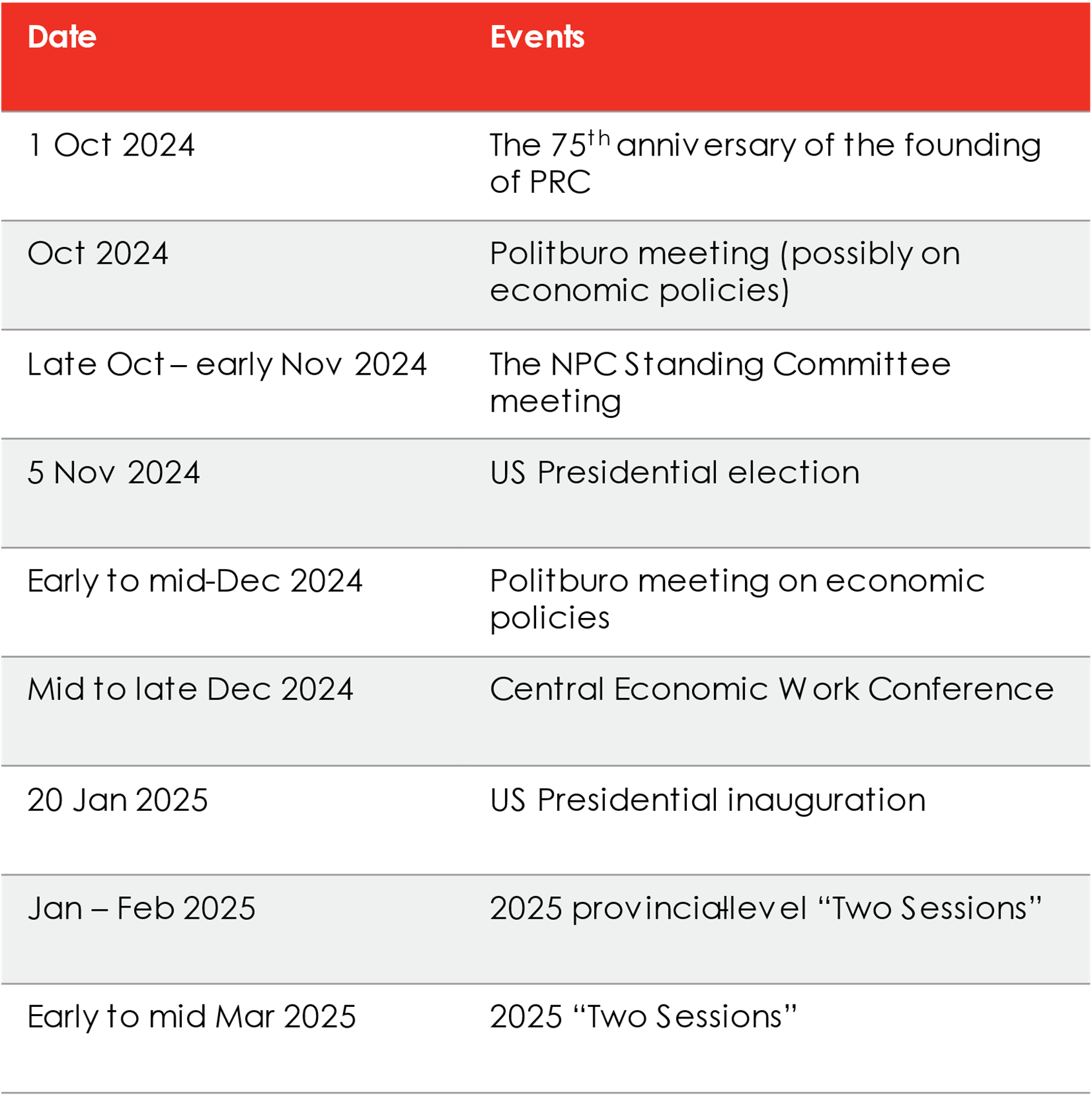
Ahead of the Golden Week celebrations to celebrate the 75th anniversary of the establishment of the People’s Republic of China, capital markets were beating to the sound of bullish calls as China unleashed a multi-prong policy blitz that drummed up investor and consumer sentiment.
On 24 September, China’s policy makers signalled a coordinated “whatever it takes” policy stimulus with a three-prong approach from monetary easing, real estate policy support and a CNY 500 billion liquidity facility for the stock market. President Xi Jinping chaired the Politburo meeting on 26 September, pledging further fiscal easing and support to stabilise the real estate sector.
Investors globally swiftly re-calibrated their stance towards China. Short covering by hedge fund and institutional investors drove one of the largest weekly rallies in over a decade. The policy blitz also triggered a rethink by offshore investors of the consensus underweight positions of Hong Kong/China equities in their portfolios. In contrast to its piecemeal policy approach earlier, China’s latest coordinated approach was a positive surprise for investors, setting off a rally in Hong Kong/China equities and CNY appreciation. This market rebound supports Bank of Singapore’s upgrade of HK/China equities at end-May 2024 in our tactical asset allocation, on the premise that a definitive policy boost could pose upside surprise for an under-owned market that had priced in excessive pessimism.
Despite last week’s pull-back, the Hong Kong/China equity markets have risen sharply since the announcement in September, with the Hang Seng Index, HSCEI Index, CSI 300 Index, SHCOMP Index gaining 16.5%, 19.3%, 16.5% and 19.3% (in the period 23 Sep to 10 Oct) respectively on record volumes.
The next shoe to drop on the policy front is widely anticipated to include a substantive fiscal package to the tune of CNY1t injection into state banks and an increase in the issuance of special sovereign bonds.
Investors’ short-term euphoria has faded into realism in the absence of greater clarity from two key press conferences last week by the National Development and Reform Commission (NDRC) on 8 October and the Ministry of Finance (MoF) on 12 October. Nevertheless, the NDRC reiterated the policy tone to accelerate the implementation of incremental policies for economic development, focusing on household conditions and consumption.
Exhibit: Upcoming events with potential impact on China’s outlook

Source: Bank of Singapore, Government websites, Goldman Sachs Global Investment Research
What this means for investors?
Will the significant rally in Hong Kong/China risk assets be sustained for the rest of the year and beyond? In the context of a multi-asset portfolio, it is important to distinguish between a tactical short-term rally, and longer-term performance of the China market, supported by positive economic and earnings fundamentals.
Impact of policy stimulus on China’s real economy:
Prior to signs of fresh policy stimulus to boost economic activity and avert deflation, investors had questioned the efficacy of supply-side credit stimulus to address China’s deflationary issues and consumption malaise. As China’s economic recovery has been weighed down by cautious Chinese consumption, lacklustre credit demand and the overhang of unsold properties, economists were cautious that lower interest rates may not be sufficient to revive credit growth.
Bank of Singapore downgraded China’s GDP forecasts for 2024 from 5.0% growth to 4.7% and for 2025 from 4.8% growth to 4.5%, following weak August data and the absence of a clear shift by policymakers. China’s economy was at risk of entering a prolonged deflationary cycle where households delay purchases and firms postpone investment, before this was addressed by the latest wide-ranging easing measures by the Chinese government.
Looking ahead, if substantive government bond issuance and fiscal boost in the form of a supplementary budget or large-scale stimulus materialises, this may catalyse upward revisions in 2025 GDP forecasts by economists. Otherwise, China’s growth may continue to slide next year on lacklustre consumption and investment demand.
1. A differentiated approach across equities, fixed income and currencies:
Bank of Singapore maintains an Overweight position since our May 2024 upgrade of Hong Kong/China equities (as part of an overall overweight of Asia ex-Japan equities) in our tactical asset allocation.
Post a sharp rally, we may see near-term consolidation in the stock market but further upside could resume if meaningful fiscal stimulus measures come through. Relative to the past four market rallies over the last decade, most Hong Kong/Chinese equity indices have recovered to the peak of the re-opening rally in 2022-23, except ChiNext Composite Index. However, they are still below those in the 2016-18 earnings-driven rally and the 2020-2021 post-Covid rally. Relative to emerging markets, MSCI China Index is still trading at around 9% discount to MSCI Emerging Market Index, in contrast to an average discount of 5% over the past five years. Positive earnings revision momentum is emerging, with MSCI China’s estimated 2024 EPS being revised up by 3.8% since May. After the sharp rally in MSCI China, the risk-reward of the onshore A-share market appears relatively more attractive, especially due to its sensitivity to policy stimulus and momentum-driven nature with higher levels of retail investor participation.
We favour large-cap, index-heavy internet and platform companies and leading consumption names, including consumer discretionary, consumer staples and communication services. Also, as the Ministry of Finance unveiled fiscal support direction focusing on addressing the risks of local government debt and real estate, we believe Chinese banks would be a key beneficiary. The stepping up in local government debt resolution and utilising local government special bond (LGSB) to fund housing inventory de-stocking will lower banks’ interest rate risks and asset quality risk.
In fixed income, we maintain our overall Neutral view on China credit and prefer quality names such as Investment Grade (IG)-rated Chinese asset management companies (AMC), high quality SOEs/POEs and selected bonds in High Yield (HY) and the Hong Kong insurance sector. For China property issuers, we remain Neutral and continue to favour central SOE-linked names and/or developers with quality land bank and large-scale quality unencumbered investment properties. A fundamental change in our view on China property will require game-changing measures such as the set-up of well-funded stabilisation fund to purchase inventories at reasonable valuations.
Bank of Singapore revised our 12-month USDCNY forecast to 7.15 (from 7.25), amid lower downside risks to the CNY but a still uncertain medium-term outlook.
2. China within a globally diversified portfolio: Opportunities and risks
The recent unexpected sharp rally in Chinese equities highlights the importance of maintaining a diversified approach to asset allocation across geographical and sector exposures. Within an increasingly multi-polar world, geopolitics, domestic economics and regulatory uncertainties can drive idiosyncratic economic and market outcomes.
Within a global portfolio context, China represents exposure to the second largest global economy, a vast consumer market and technology innovations, notwithstanding the risks in consumption, real estate and deflationary concerns. While market narrative is currently focused on China stimulus and easing measures, geopolitics could return to the forefront in the run-up to the US Presidential Elections next month. US-China tensions will likely persist, especially with potential outcomes relating to tariff increases on Chinese goods and restrictive trade policies.
At a broader level, it is important to build well-diversified global investment portfolios with exposure to the drivers of economic growth and innovation. This includes overall Asian exposure comprising China, Japan, India and Southeast Asia, as well as alternatives and gold for sustainable and resilient multi-asset portfolios.
This article was first published in The Business Times.